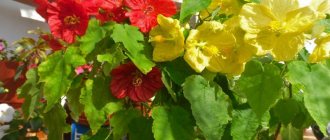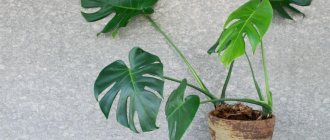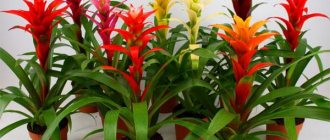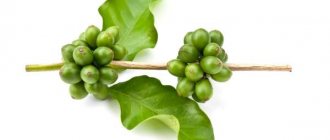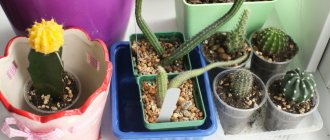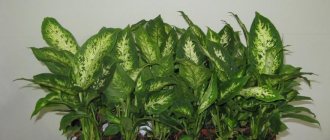The spectacular Haworthia of the Xanthorrhoeaceae family, subfamily Asphodelaceae, is often cultivated as a house plant. Dwarf and miniature succulents prefer well-lit window sills, terraces or balconies, but do not tolerate heat.
The flower received its name in honor of Adrian Haworth, an English botanist, which determined its place in the classification.
Botanical description with photo
Haworthia (lat. Haworthia) does not have colorful leaves and is not rich in flower buds, but the wide range of leaf shapes of the graceful succulent has invariably attracted the attention of gardeners for many years.
Botanical characteristics of the crop:
- The leaves are fleshy, dark green in color, in some species they are covered with white, warty tubercles, the edges are smooth, with “cilia”, denticles or long spines.
- The rosette is basal, of linear and pointed sheaths, which, depending on the variety, are widely spaced or tightly fitted to each other.
- The peduncles are long, it is recommended to cut them off to avoid depletion of the plant.
- The buds are small, white, almost identical in most species, and rarely appear at home.
- Root system - there are 3 types. The first ones are thick, increase in size when moistened, and disappear into the ground on their own when dry. The latter are fleshy and create an extensive network. Still others live in the above-ground part and pull the plant into the ground until the leaves are alive when the dried ones fall off.
What kind of plant is this?
Haworthia is a perennial plant characterized by its small growth. We can say that it is a shrub without a trunk or with a small trunk. In adulthood they can reach 12 cm in height. Many species are characterized by shortened stems that branch well. They also often have daughter rosettes and side shoots. You can learn about the most popular types of Haworthia here.
The leaves of the plant are convex at the bottom. They are tough, leathery, fleshy. They are often characterized by a triangular shape. They can be blunt, elongated or cut off at the end. They are often characterized by a warty surface with a large number of tubercles. They form the transverse rows. The color can be dark green with blue, it can also have brownish shades.
Some species have a transparent epidermis, under which there is aquiferous tissue. Such rosettes can form turfs, which consist of suckers. Flowering is not particularly valuable. The flowers have a cylindrical shape, they are characterized by 6 petals that grow together at the bottom. They are greenish-white or pale pink in color.
Note! The peduncle should be removed in advance, since many species may die after flowering.
Types for indoor growing
More than 100 species of this plant are known to exist. Several species are suitable for growing at home, here are some of them:
- pearl;
- tortuous;
- Cooper;
- dwarf;
- attentuate;
- scaphoid;
- Limofolia;
- mosaic;
- chopped off;
- arachnoid;
- striped.
Read more about varieties and hybrid varieties of succulents for growing on a windowsill here.
short biography
The Republic of South Africa is considered to be the birthplace of the plant. In this country, Haworthia grows in abundance in natural conditions. It was in South Africa that the succulent was found by an English botanist, in whose honor the flower got its name. These and other autobiographical details of the dwarf plant are indicated in the table.
Table - Biography of Haworthia in questions and answers
| Question | Answer |
| Genus | Succulents |
| Family | Asphodelaceae |
| Place of Birth | Africa, South Africa |
| Discoverer | Adrian Hardy Haworth (botanist) |
| Maximum height | 12 cm |
Blooming haworthia is a completely unattractive sight. The plant produces a long peduncle, on which an unsightly flower of gray-pink or light green color is formed. In their reviews, experienced flower growers recommend removing the peduncle immediately after detection. The need to take such emergency measures has a good reason: most succulents die after flowering, and it is no longer possible to revive them.
Location and lighting
No succulent will grow well in low light. A miniature flower needs bright sun, but without direct rays.
Therefore, it is best to place haworthia on windows facing south, southwest and southeast.
At the same time, we must not forget about its protection in the summer in the afternoon.
What do representatives of the Asphodelov family suffer from and who are they afraid of?
There are not many recommendations on how to care for haworthia after purchase; this plant can be called problem-free. At least in comparison with other, much more capricious residents of apartment window sills. However, difficulties do happen. Diseases and pests are rare for Haworthia. But their sudden appearance can create a lot of problems for both the flower and its caring owner.
5 gardener mistakes
The condition of the succulent quickly reveals mistakes made by the grower when growing an ornamental plant. If you carefully monitor the symptoms, you will be able to quickly correct the situation and carry out appropriate treatment. Listed below are five common “signs” that your succulent is in trouble.
- Loss of decorative appearance. The plant loses its decorative appearance if it stands in the shade. Pay attention to the location of the haworthia. Perhaps it should be changed to something more suitable.
- The leaves are drying. This happens due to a long absence of watering. And also in the case when the air in the room is excessively dry.
- Blackening and softening of leaves. If the haworthia turns black, it means it is too cold. Perhaps the plant was left in a cold draft.
- Redness or yellowing of leaves. A change in the color of the leaf blade is a clear indication that you have overdid it with fertilizing.
- An elongated shoot. Apparently the Haworthia doesn't have enough light. Therefore, the plant decided to reach for the sun on its own.
Enemies among insects
The main enemies of Haworthia among insects are mealybugs and scale insects. The plant can become infected from neighbors on the windowsill. In addition, parasites can get on the succulent in the summer, when the haworthia breathes fresh air in the flowerbed or in the country house. You can rid your dwarf pet of annoying pests using a combination of two methods.
- Hot shower. The water temperature must be above 45°C. In order not to over-moisten the soil, the pot must be covered with cling film or a plastic bag, fixing the protection at the base of the outlet. A hot shower will wash away insects, remove larvae and traces of destructive pest activity from the plant.
- Treatment with insecticides. Sometimes a hot shower is enough to eliminate insects. But if this does not help, the succulent must be sprayed with a chemical. It completely and irrevocably eliminates pests.
Caring for the charming Haworthia is a pleasure. She is not capricious or pompous. It grows in a low pot - and knows no grief. And along with her, the florist who produces a succulent family on the windowsill and enjoys the view of the variegated fleshy foliage does not know grief.
Growing haworthia from seeds or propagating it in other ways will allow you to create florariums. Miniature glass greenhouses filled with succulents can not only decorate your home, but also a unique business idea. “Clone” haworthia using accessible methods, place it in round vases or mini-aquariums, create unique flower arrangements - and sell. Or pamper your loved ones with unusual living gifts!
How often to water and spray at home?
Unlike other succulents, a representative of the Xanthorrhoeae family will not be harmed if watering liquid gets inside its rosette. Moreover, it is recommended to irrigate haworthia using the sprinkling method, while observing the following conditions:
- regular ventilation of the room;
- mineral components in the soil.
Due to waterlogging, the root system of the flower rots, which begins to actively increase its mass in the event of poor irrigation. Water at room temperature is suitable for irrigation. In the summer between procedures, the substrate should dry out by a third, in the winter - completely.
Diseases
With proper care, haworthia rarely gets sick, so if the plant shows signs of illness, you need to change the system of caring for it.
- If the leaves have unnaturally lengthened and the rosette itself has become loose, this is a consequence of a lack of light. It is necessary to provide the flower with additional lighting.
- If the leaf plates not only stretch out, but also bend, and the growths on them become dull, the room is too hot. It is necessary to adjust the temperature regime in accordance with the preferences of the flower.
- If the tips of the leaves are dry and curled, the flower is stuffy. The room should be ventilated and the humidity level should be increased.
- If the rosette of leaves has stretched out, the root system does not have enough space in the pot. The flower needs to be transplanted into a larger container.
- If brown spots appear on the leaves, the plant has been negatively affected by direct sunlight. It is necessary to create a shadow for the flower.
- If the lower tier of leaves has become sluggish and watery, the haworthia has been flooded. The frequency of watering should be reduced.
- If the leaves have changed color, the soil contains an excess of mineral salts. The flower needs to be replanted.
Choosing a pot
Round ceramic pots with rough walls are best suited for growing exotic succulents, since it is very difficult for dried roots to cling to a smooth surface. And this creates a high probability of their rotting.
Also, you should not take containers that are too large, since the soil in them takes longer to dry out, which can cause overflow of the crop.
Composition of soil for succulents
A representative of the Xanthorrhoeae family does not tolerate acidic soil at all, which is why for cultivation it is better to choose a substrate with a weak or neutral reaction. The soil should not contain more than 50% organic matter. Otherwise, it will quickly acidify.
A mixture of pumice and lava particles, with a small amount of nutritious soil, is ideal. You can also make the mixture yourself from 3 parts peat, coconut fiber and sand, 1 part clay and 2 parts expanded clay.
How to make a succulent garden - video
Haworthia turned out to be completely unpretentious in care. The variety of species will allow almost any gardener to choose a plant to their liking. And if you also create a mix of succulents, you can bring a unique charm to the interior of your apartment.
- Author: Diana Nikiforova
I never cease to be convinced that life is wonderful. Rate this article:
- 5
- 4
- 3
- 2
- 1
(3 votes, average: 4.3 out of 5)
Share with your friends!
When to replant after purchase and more?
After purchasing, the haworthia must be immediately moved to another pot, since the transport soil is not suitable for its development, and the roots of the crop may be damaged.
Adult crops are transplanted to a new habitat no more than once every 2-3 years.
Step-by-step instruction:
- A layer of mineral mixture is poured into the bottom of a suitable pot so that the root system barely reaches it.
- Next, the plant to be moved is held above the center of the pot, while filling the sides with substrate.
- After such manipulation, the socket should be flush with the ground surface.
- The succulent is watered 2 days after transplantation, and the released liquid is immediately removed from the pan.
Reviews from flower growers
Haworthia is suitable for those who sometimes forget to water their flowers, because they come from arid countries and are able to retain water in the stem and leaves for a long time.
Beautiful, lush green, rough leaves captivated me with their beauty. On the kitchen windowsill, in an area of direct sunlight, the plant began to quickly wither, and the leaves began to rot and fall off. After transplanting it into another flower pot for cacti, I left it in the bathroom on the washing machine. And what do you think? Juicy greenery, new shoots simply filled the pot, I had to plant it out. Gardekja
https://otzovik.com/review_820753.html
I like it so much that I talk to it, it doesn’t bother me to care for it, it grows very slowly, anyone who grows it knows.
I heard that it can even bloom occasionally, but that didn’t surprise me. Clarice
https://irecommend.ru/content/vot-nichego-s-khavortiei-osobogo-ne-delayu-tolko-razgovarivayu-i-polivayu-ona-rastet-foto
A beautiful plant, completely unpretentious to care for.
Looks great on your desktop near your computer or on the windowsill. Beautiful living joy. Siderted
https://otzyv.expert/ekzotika-na-okne-1385279
Reproduction
The seed propagation method is usually used by professional flower growers who grow hybrids. For amateurs, vegetative methods are more preferable.
Root with leaf
A leaf plate up to 10 cm long is cut from the mother plant, the cut is treated with activated carbon, dried and rooted. The first watering is carried out only after 3 weeks.
Seeds
Seeds are laid out on the surface of wet peat or sand. Then the material is covered with glass or cling film and wait for germination, exposing the container to light at a temperature of +20...+25 degrees.
Separate baby
This method is most conveniently carried out simultaneously with transplanting the crop, because some children already have their own roots and can be placed in ready-made containers.
Daughter rosettes without roots should be separated with a blade or sharp knife, dusted with activated carbon and placed in cups with wet sand or perlite. After the appearance of the vegetative organ, 1-2 tbsp is poured into each container. spoons of water, and after 2 weeks they are transferred to the substrate familiar to the culture.
The main advantages of Haworthia
If necessary, Haworthia can go without water for up to several weeks, without forcing you to rack your brains about who to entrust watering to during the holidays.
Thanks to this, it is an excellent idea for a gift that does not burden the recipient, because it is suitable for both home and office, and is able to endure long separations from a person without compromising its well-being.
In addition to being a very convenient houseplant, Haworthia boasts a huge number of different varieties. To all the other positive qualities of Haworthia, another bonus is that it is not poisonous to people or animals.
Possible problems with leaves and how to revive them?
If the maintenance rules are not followed, haworthia may lose its attractiveness.
What to do if you are stretched out?
In low light conditions, the rosette stretches out and becomes loose.
By satisfying your haworthia's need for sunlight, you will quickly improve the situation. It could also be due to a lack of nutrients or a small pot. The first problem is solved by feeding, the second by transplanting.
The ends are drying out
The air in the room where the flower is located is too dry. To increase the humidity level, it is recommended to place a container of water next to the pot.
Turn red or yellow
This problem indicates that the crop has developed sunburn. The plant urgently needs to be shaded with a curtain. Also, excess fertilizer may be to blame - you will have to update the substrate.
They rot and turn black
The essence of the problem lies in the air temperature, which is below normal. Damaged plates should be removed. At the same time, adjust the temperature regime at the same time.
Difficulties in keeping haworthia
Elongated leaves, looseness and elongation of the rosette are a lack of light. The plant needs to be moved to a western or eastern window. If haworthia is grown in composition with other plants, then it is placed at the base of large ones.
The leaves are elongated, the edges are bent, the growths become dull - the temperature is too high in winter. It is necessary to reduce the temperature to 10 ° C
During the dormant period, the ends of the leaves dry out and curl at the edges - excess heat and dryness. Necessary protection of the plant from hot air. Glass or placing the pot in a tray with wet pebbles will help.
The flower changes shape and grows in length - it needs replanting and feeding. Be sure to separate the children. If brown spots appear on the leaves, shade the plant.
An interesting property of Haworthia is that it requires light for 3-4 hours. Accustoming to the sun begins gradually in the spring to avoid burns.
The lower leaves come off easily and are limp - the plant is flooded. It is necessary to stop watering until the plant is completely restored.
The color of the leaves changed to pale, yellow, red - excess fertilizer. You can feed once a month. Fertilizing with fertilizers with a high nitrogen content is unacceptable.
The leaves turn black and rot - the soil is very wet, the temperature and air are very low. The plant is urgently brought into the house.


